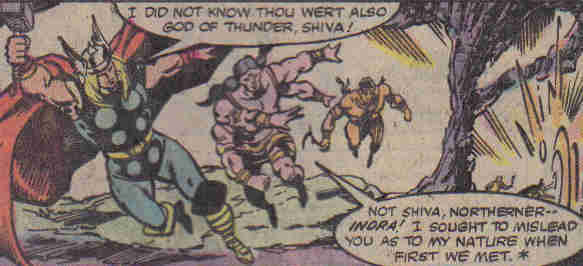
INDRA 
Real Name: Indra
Identity/Class: Vedic/Hindu God
Occupation: God of storm and thunder
Group Membership: The Adityas (Vedic Gods), The Devas (Hindu Gods) and Yazatas (Gods of Persia)
Affiliations: Apollo, Horus, Quetzalcoatl, Shango, Tawa, Thor, Vishnu
Enemies: Atum the Demogorge
Known Relatives: Dyaus (father), Gaea (mother, alias Prithivi), Agni, Tvashtri, Surya, Vayu (brothers), Ushas, Ratri (sisters), Vishnu, Brahma, Shiva (half-brothers), Dharma, Skanda, Ganehsa, Yama (nephews), Padma, Saranyu, Kâli (nieces), Lakshmi-Sri, Sarasvati, Parvati (sisters-in-law),
Aliases: Indr (alternate spelling), "Shiva" (SEE COMMENTS)
Base of Operations: Svarga
First Appearance: Thor I#301(November 1980)
Powers/Abilities: Indra possesses the conventional attributes of the Hindu gods although his strength and stamina are far in excess of the majority of the Hindu gods. He has superhuman strength (Class 100), stamina, longevity and resistance to harm. He can also conjure and create storms and rain. He is an accomplished warrior, often seen carrying a variety of weapons including swords and sikhs (daggers); his weapon of choice was his vajra, a long curved sword. In ancient times, Indra rode upon Airavata, an elephant-mount. In modern times, he rides a chariot pulled by four horses capable of traversing through the air.
Unusual Physical Traits: Indra has violet skin and four arms. In ancient times, he had gold skin.
History: (Vedic-Hindu Myth) - Indra is the son of Dyaus, the ancient Vedic god of the sky, and Prithivi, the Vedic god of earth. Worshipped as gods by the Vedic ancestors of the modern Hindus, Indra was revered as one of the most important Vedic gods. With powers of storm and thunder, Indra defended the Vedic gods from their enemies, often invigorating himself on soma, the drink of the gods. However, Indra eventually became so drunk that he slew Vritra, one of the Danavas or serpent-gods in the Vedic Pantheon. Vritra had coiled up at the bottom of Mount Himavat preventing rain from falling to earth and had been enchanted that he was impervious to weapons. In order to slay him, Indra turned the sea to foam and drowned the serpent-god in the depths of the sea. Vritra had been close friends of Vishnu, and his death brought great sadness over the Vedic gods. As punishment, Indra had to surrender his elephant-mount, Airavata; it's head being used to revive Ganehsa, the slain son of Shiva.
 (Thor
I#301 (fb) - BTS) - In Shiva's absence,
Indra was invited to take his seat in the Hindu Trimurtri.
(Thor
I#301 (fb) - BTS) - In Shiva's absence,
Indra was invited to take his seat in the Hindu Trimurtri.
(Thor I#301) - When Thor came to Nirvana, the cosmology of the Hindu gods, to seek a portion of the life energies to revive his fellow Asgardian gods, Indra challenged Thor considering him to be a deity with waning power. Indra had decided to vote against donating the energies to revive the Asgardians, even engaging Thor in battle, but upon realizing the passion of Thor's conviction, Indra relented and eventually donated the energies required.
(Thor Annual#10) - Vishnu sent Indra into the underworld to defend earth from Demogorge accidentally released by Yama and a host of other gods of the dead in order to forge an attempt to stave off its release. Although briefly consumed by the primeval entity, Indra was released unharmed after Thor appealed to Atum's consciousness within Demogorge and caused a reverse in its palate.
Comments: Adapted by Mark Gruenwald, Ralph Macchio, Keith Pollard and Chic Stone
If you're looking at this entry and wondering, "What the hey, you did this guy already?!" Well, here's the yin-yang on the whole kibosh thing: Back when Thor #301 came out, several readers of the Marvel Universe of the Hindu faith were a bit perturbed that Shiva could be beaten (well, he wasn't beaten; it was more of an agreed stalemate) by Thor, so when Thor Annual#10 came out, Marvel decided to get a little creatively theatrical and decided that that wasn't really Shiva, but Indra, the old Vedic/Pre-Hindu thunder-god in order to calm several of its readers. That means Shiva's first appearance in the MU does not actually happen until a cameo in Thor I#398 and in person in Thor II#61.
In Vedic and preceding Hindu myth, Indra is considered the half-brother of Vishnu, but just how is unrevealed considering their varying and differing parentage. However, for the sake of the Marvel Universe, it is theoretical that Prithivi and Ammavaru are separate names of Gaea, Mother Earth.
Indra also has an entry in the Guide to the Mythological Universe.
Profile by: WillU
CLARIFICATIONS: Indra is not to be confused with:
Images:
Thor Annual I#10, page 22 (nor counting ads), bottom right
Thor Annual I#10, page 25 (nor counting ads), middle
Issues:
Thor I#301 (November 1980) - Mark Gruenwald & Ralph Macchio (writers), Keith Pollard (pencils), Chic Stone (inks), Jim Salicrup (editor)
Thor Annual I#10 (1982) - Mark Gruenwald (writer/editor), Alan Zelenetz (writer), Bob Hall (penciler), Rick Bryant, Joe Rubinstein, Andy Myshynsky, Al Gordon, Kevin Dzuban (inkers)
First Posted: 06/03/2007
Last updated: 06/03/2007
Any Additions/Corrections? Please let me know.
Non-Marvel
Copyright info
All other characters mentioned or pictured are ™ and © 1941-2099 Marvel
Characters, Inc. All Rights Reserved. If you like this stuff, you should check
out the real thing!
Please visit The Marvel Official Site at: http://www.marvel.com
Special Thanks to www.g-mart.com for hosting the Appendix, Master List, etc.!